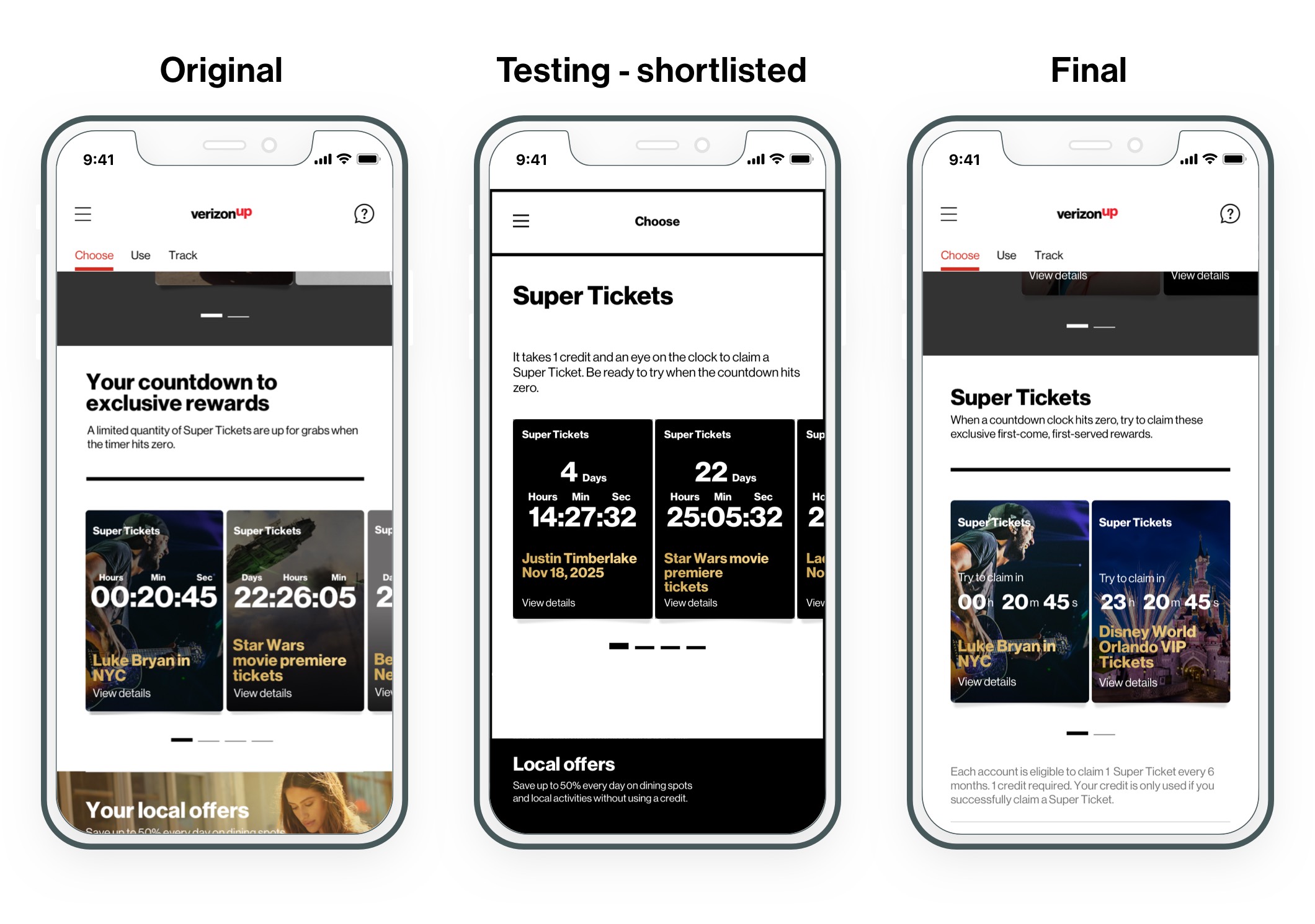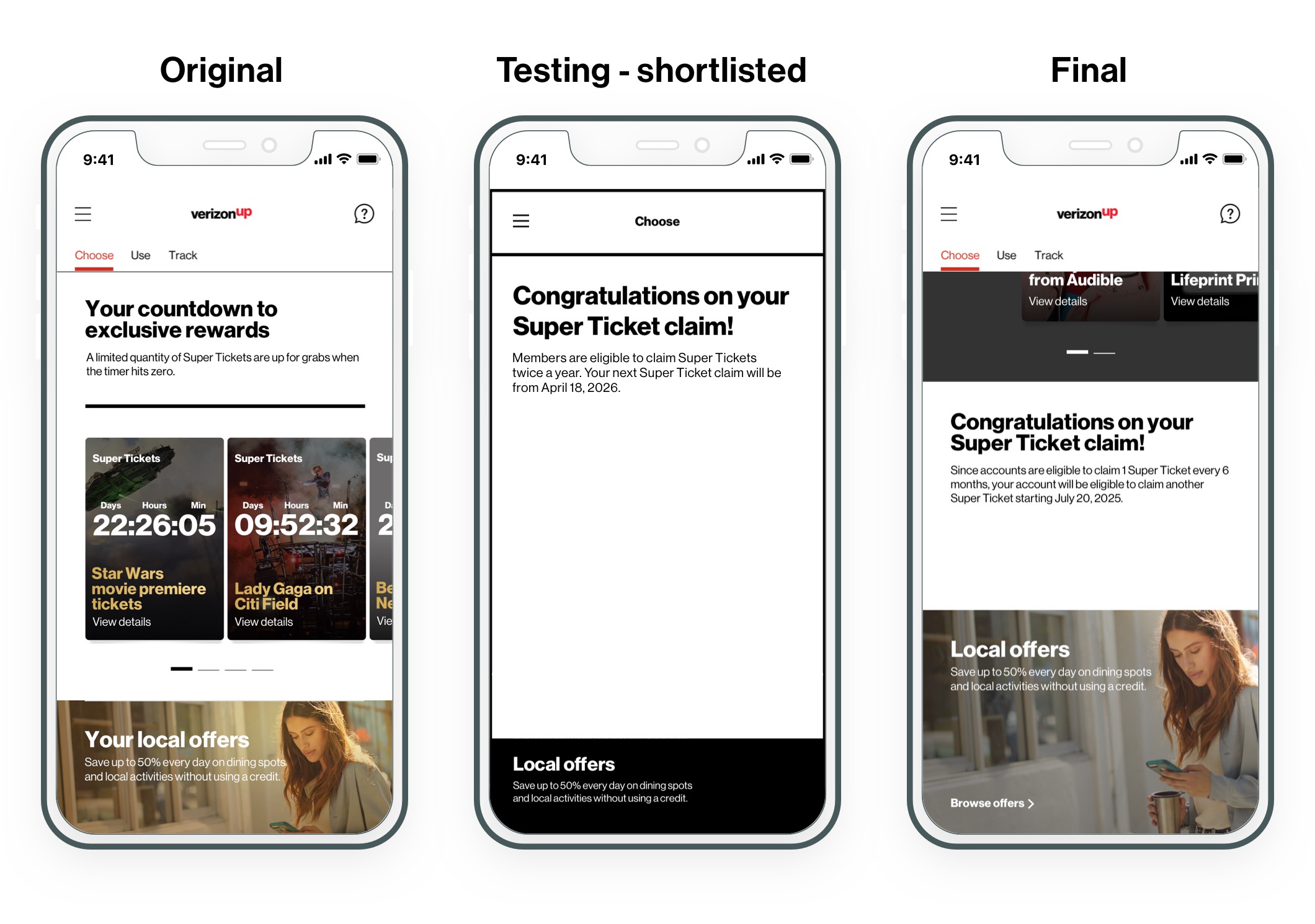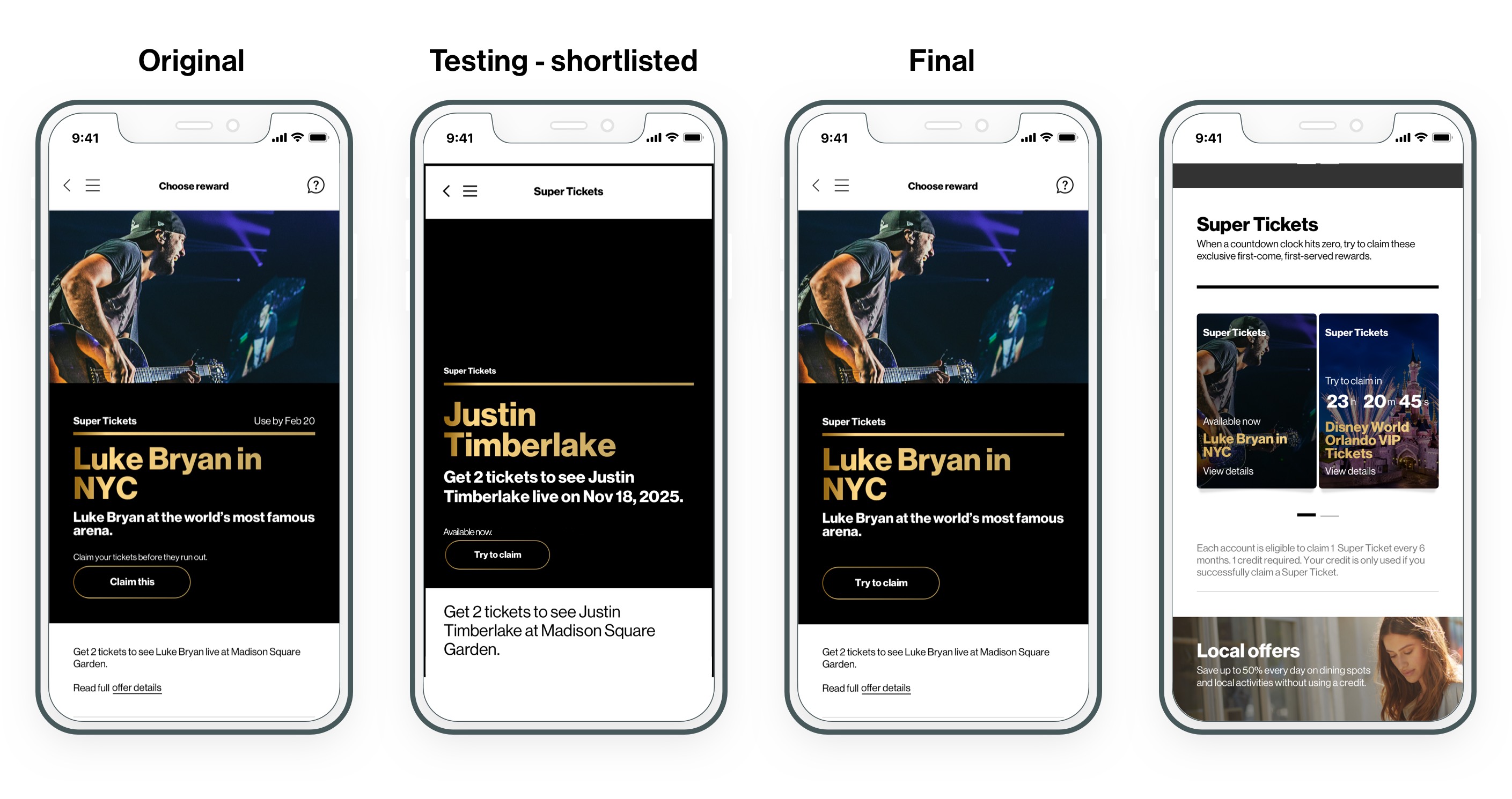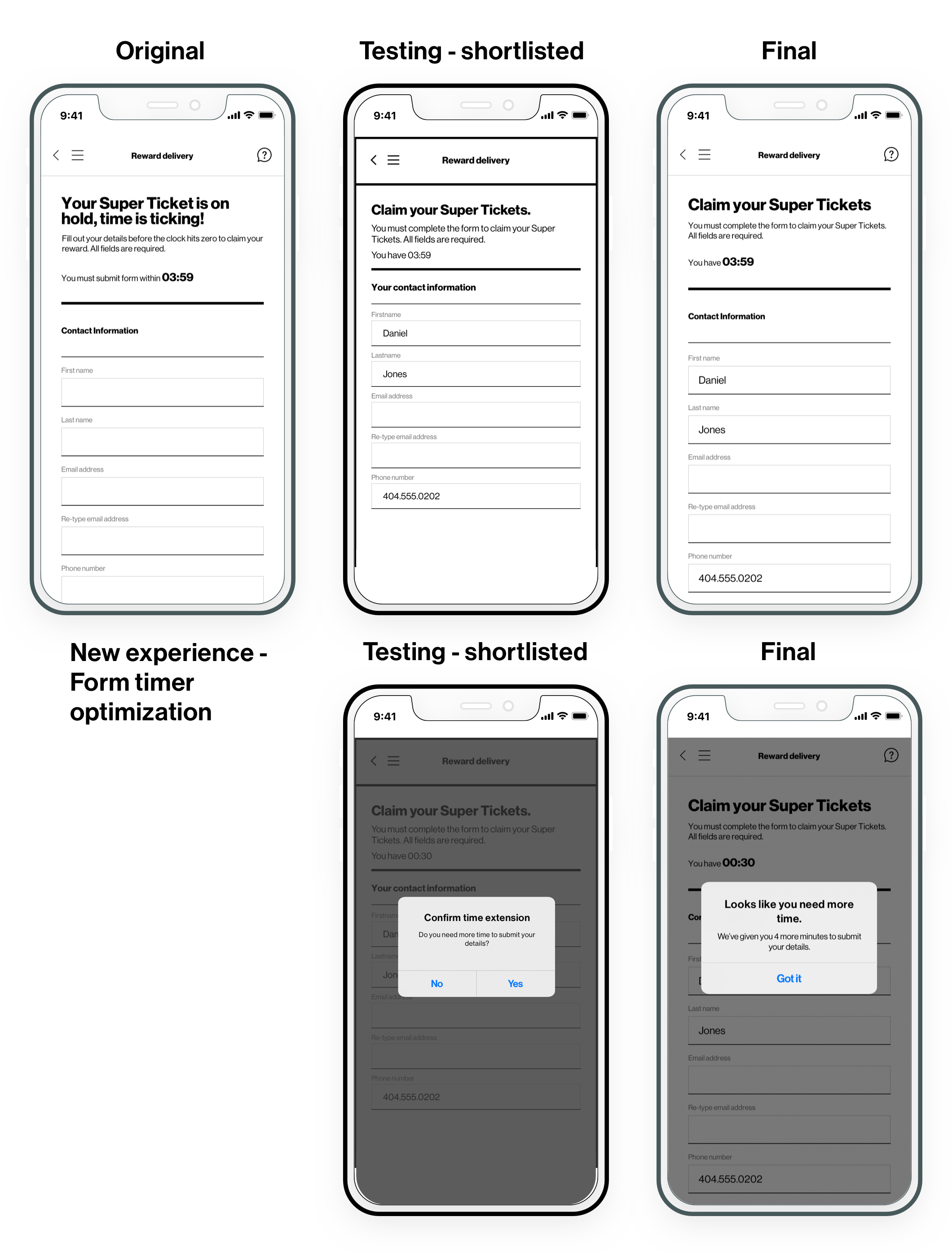Verizon Up - Super Tickets
MOBILE APP
Super Tickets is a rewards offering to Verizon Up members, giving them access to exclusive events. Twice a year, when the countdown clock hits zero, members can use their monthly credit and try to claim it on a first-come, first-serve basis.
The lack of clarity and comprehension around the participation rules tainted customer excitement to participate to the event.
Customers seemed to be unclear as to why they were not winning, when the claim process seemed similar to other sections of Verizon Up. Having to enter known delivery details with a short time constraint, and the lack of visibility on the delivery status was frustrating to members.
On the business side, there was a decline in participation, with calls to the customer care team increasing. At times, tickets were left unfullfilled due to erroneous information submitted.
The Verizon Up Design team was tasked with bringing awareness and clarity around the Super Tickets participation rules to increase customer participation and reduce customer care calls.
SKILLSAudit, competitive analysis, needs and pain points, Research stimuli materials, Key area redesign prioritization, concepting, User flows, Site map.
1. Discovery
Research began with reviewing the Super Tickets existing artifacts. The materials included user flows, research results, Voice of customer feedback and Customer care feedback.
Our objective was to clarify and validate our understanding of the current Super Ticket claim experience.
It allowed us to identify discrepancies and opportunities, focusing specifically on these four areas:
- Understand the design rationale of the Super Tickets claiming experience, distinct from other reward claiming process.
- Evaluate content reflecting participation and eligibility rules and their pertinence across the experience.
- Identify gaps between the documented and actual flows.
- Identify customer and business needs, as well as pain points.
My primary focus was to audit the multiple user flows and diagnose gaps, disparities, or opportunities between documented and actual flows.
Key findings
- Outdated content were found in the documented user flows that needed refinement in accuracy and representation.
- No additional disparities were discovered between the documented and actual user flows.
- Having the Super Ticket change location when they were available to claim was intended to keep customers engaged during the live event.This discovery indicated that it might be triggering the increase in API calls.
- The only communicated participation rule for members was the ticket claim availability; There was a lack of participation and eligibility rules presented to users across the experience.
I shared my discovery of outdated content in the documented flows with the team, and after agreement, I refined their accuracy and representation, establishing a new baseline for the UX writer's content design work.
One of the updated flow can be found below.
To conclude our audit, we needed to convert our insights regarding the needs and pain points for both customers and the business into a clear format.
Collaborating with the product manager, I organized and translated the findings into a comprehensive and actionable list, ensuring its validation.
Turning our attention to the competition, we looked into how they handled time-based ticket availability in live or offline events. This method was seen across Concerts, Events, Sweepstakes, Contest, Lottery, and Music Venues.
The time-based concept was universally used for both live and non-live events. Live events were driven by speed in a matter of hours, minutes requiring immediate feedback, whereas non-live events focused on a submission date, with results given during a later defined date.
The London Symphony Orchestra, Hamilton Lottery and Disney movie rewards used techniques to entice and keep customer engaged while preventing technical strain on their server.
The analysis was completed by capturing how participation rules were communicated across the experiences to users under the guidance of the UX writer.
Our examination continued by conducting a feature analysis, comparing and organizing features and services from Verizon and its competitors.
Below is an excerpt of the analysis we have performed.
Features |
Verizon | London Symphony Orchestra | Hamilton Lottery | Disney Movie Rewards | |
|---|---|---|---|---|---|
| 1 | Countdown clock | Verizon | LSO | Hamilton Lottery | Disney Movie Rewards |
| 2 | Reward details | Verizon | LSO | Hamilton Lottery | Disney Movie Rewards |
| 3 | Participation rules | Verizon | LSO | Hamilton Lottery | Disney Movie Rewards |
| 4 | Event details | Verizon | LSO | Hamilton Lottery | Disney Movie Rewards |
| 5 | Number of tickets given | Verizon | LSO | Hamilton Lottery | Disney Movie Rewards |
| 6 | Fullfilment form | Verizon | LSO | Hamilton Lottery | Disney Movie Rewards |
| 7 | Waiting room | Verizon | LSO | Hamilton Lottery | Disney Movie Rewards |
| 8 | Numbers of participants | Verizon | LSO | Hamilton Lottery | Disney Movie Rewards |
| 9 | Event Reminder notification | Verizon | LSO | Hamilton Lottery | Disney Movie Rewards |
| 10 | Inventory (quantity available) | Verizon | LSO | Hamilton Lottery | Disney Movie Rewards |
| 11 | Confirmation follow-up | Verizon | LSO | Hamilton Lottery | Disney Movie Rewards |
This process validated existing features and identified 4 potential enhancements for the Super Tickets experience to entice customers.
The new features included:
- The waiting room.
- Participants count display.
- Event reminder notification.
- Remaining tickets inventory display.
Before proceeding with any new features, we needed to assess their technical feasibility with tech and product management.
If validated, our goal was to gather customer feedback and interest in the concepts through user testing.
Design recommendation
The proposal was to integrate up to 2 new features, supported by key user flows and prototypes and to be validated for feasibility with our tech team and product manager.
Product and Technical feasibility
However, we learnt that numbers display wasn't feasible due to an internal rule, the waiting room feature was excluded for its tech complexity, and the event reminder notification required a timeline adjustment.
Feature implementation
Collaborating with our tech and product partners, I negotiated and secured both approval to validate user interest in the event reminder notification and implement the feature in an upcoming sprint.
We cross-referenced past artifacts, along with competitive and feature analysis. This examination was to confirm and identify specific aspects of the Super Tickets experience that required redesigning or improvement.
We established that the emphasis should be on the Super Tickets rules throughout the claim experience and the key areas to focus our solution were:
- Super Ticket Section.
- Super Ticket Reward.
- Super Ticket Claim.
2. Design explorations
We ideated content variations and experience improvements for key areas, selecting 2 to 3 variations for each to avoid overwhelming user testers. These were then transformed into prototypes.
Content experiments gravitated around:
- Claiming time
- Time-based and first-come, first-served basis
- Winning probability
- Eligibility frequency
- Credit usage rule
Experience improvements focused on conveying future eligibility and form timer optimization.
The primary objective was to gain user feedback during the initial stages of design to address comprehension issues and guide the refinement of our experience improvement designs.
Recognizing the substantial impact of content design on the overall experience redesign, we anticipated the need to test multiple content variations for key areas to ensure validation.
To streamline this process, we opted for the creation of paper prototypes, serving the dual purpose of accommodating content variations and experience improvements. The choice was motivated by:
- Their quick production, allowing for a rapid iterative process.
- Their ability to present multiple variations simultaneously for comprehensive testing.
An excerpt of the paper prototypes can be found below.

3. User testing and Design iterations
Five user testing sessions with 25 participants took place and were moderated to provide context to the concepts and identify gaps and opportunities in the claim experience flow.
The design team observed all the sessions and based on insights gained from testing, we iterated on the solution to reach a final proposal.
The Choose Tab hosts the Super Tickets section, featuring all upcoming Super Tickets for users to attempt to claim, accompanied by participation and eligibility rules.
Users were presented with one participation rule. The lack of clarity around their winning chances, eligibility and credit usage caused confusion and frustration to users wanting to participate.
Three moments were identified for redesign and 2 are presented in this case study:
- During the countdown.
- After a successful claim.
1. During the countdown
In the countdown phase, we noticed inconsistencies in the Super Tickets section title compared to other sections on the page. It also lacked specificity about the type of rewards. The participation rules were limited, displaying only one.
To address this, our solution focused on enhancing key participation rules:
- Clarify when Super Tickets can be claimed.
- Emphasize the time-sensitive and unrestricted nature of the reward.
- Provide clarity on winning probability.
- Specify eligibility frequency and rules.
- Detail the required number of credits.
- Explain the usage of credits.
The paper prototypes incorporated the revised section title, credit requirements, and ticket availability.
Testers were challenging the comprehension around participation rules and eligibility to try to claim alongside any functionality and experience flaws.


Content audit findings
The title did not sufficiently specify the type of rewards available in the section.
The ticket claim availability was the only participation rule explained.
User testing feedback
Users appreciated the revised title aligning with the types of rewards, consistent with other sections.
Users valued the reference to the required number of credits.
However, some users still perceived that the win was guaranteed.
Users raised questions about credit usage in the event of an unsuccessful claim.
Design refinement based on user insights
The section title was maintained to align with the types of rewards for consistency with other sections.
The content order was adjusted to begin by specifying the availability of Super Tickets, emphasizing that it does not guarantee a win, and tickets may be claimed quickly.
The eligibility frequency was specified and clarified that a credit would only be used when successfully claiming a Super Ticket to reassure users.
2. After a successful claim
Following a successful claim, the Super Tickets section displayed upcoming Super tickets to users that they were not eligible to claim for another six months, misleading users. Unintentionally, their participation resulted in avoidable additional API calls.
For this solution, the participation rule considered was:
- Clarify eligibility frequency and rule.
Paper prototypes integrated Super Tickets eligibility rules, claim frequency, and upcoming eligibility date..
The testing was to gather user's feedback on their understanding of the eligibility frequency and rule.


Content audit finding
The section did not provide an explanation for Super Ticket claim eligibility.
User testing feedback
Users found the section title modification to be more contextual with the supporting copy, which was well-received.
Users appreciated understanding why they couldn't claim and the specific date when they could start claiming Super Tickets next.
Users preferred not encountering Super Tickets they couldn't claim.
Design refinement based on user insights
Due to positive user feedback regarding the section title modification, the change was retained.
Considering users' preference for date references, the eligibility sentence was revised to indicate "in 6 months."
Reward details include the date, description of the event, its location, the number of tickets or specific rules related to the event.
During the countdown, the disabled CTA was clear to users that they couldn't claim the reward.
When the reward was available to claim:
- The reward card would move to the "New Rewards" section creating disruption in the experience.
- On the reward detail, the CTA label misled some users to think that claiming would be a guaranteed win.
Four moments were shortlisted for redesign and 2 are presented in this case study:
- During the countdown.
- When Super Tickets are available to claim.
1. During the countdown
During the countdown phase, utilizing the term "use by date" as the event date on the reward details gave the impression among users that the reward had already been claimed.
Additionally, the CTA label led users to believe that claiming the reward would guarantee a win.
The participation rules to consider in this solution were:
- Explain when Super Tickets can be claimed.
- Clarify winning probability.
The paper prototypes included an improved countdown display, the CTA label modification, additional content to eliminate ambiguity regarding winning chances and moving the event date under the title to prevent confusion.
This time, we needed the tester's opinion on their comprehension around winning chances and reward availability to be claimed.


Voice of Customer and customer care calls findings
Some users found the presentation of hours, minutes, and seconds on the countdown clock unclear, while others felt the numbers were overly prominent.
Having "Use by" date gave the impression that the rewards were already claimed.
The CTA label "Claim this" mislead some users who understood that the claim would be a guaranteed win.
User testing feedback
While some users appreciated the improved clarity of the countdown with abbreviations for hours, minutes, and seconds next to the corresponding numbers. Others still faced readability challenges.
Users who were frustrated for not winning preferred the button label change as it clarified their winning chances.
Design refinement based on user insights
The readability was improved by refining and de-prioritizing the abbreviations for hours, minutes, and seconds next to the corresponding numbers.
The message supporting the button label was refined to "Try to claim when the countdown gets to zero", clarifying when tickets would be available to try to claim.
Changing the CTA label to "Try to claim" helped users understand that the win was not guaranteed, lifted ambiguity, and would prevent customer care calls.
2. When Super Tickets are available to claim
a. In the Super Ticket section
At the countdown's conclusion, the reward's relocation to another section compelled users to scroll to the top, impeding their claiming speed and diminishing winning chances.
This change in reward location deviated from the consistency observed in other sections and triggered additional API calls.
The proposed redesign in this solution was:
- Reevaluate the reward location upon availability.
Design recommendation
The proposal was to present the available Super Ticket(s) within the existing section rather than moving them to the "New Rewards" section. I illustrated our design intent with a user flow and prototype.
Technical feasibility
Initiating collaboration with our Tech team and product manager, I discussed the artifacts and design rationale from a feasibility standpoint. Following the tech validation, the prototype was presented to users to gain insights.
The objective was to gauge testers' reactions to the Super Ticket location when the countdown concluded and it became available for claiming.


Voice of Customer finding
Users found it disruptive when they had to navigate to another section to claim Super Tickets.
User testing feedback
All users preferred claiming the rewards in the Super Tickets section.
Design refinement based on user insights
Keeping the reward in the Super Tickets Section minimizes interruption, brought cohesion between sections and reduced API calls.
b. On the Super Ticket reward details
Upon the availability of a Super Ticket, the reward details provided to users emphasized the scarcity of the ticket, intensifying the pressure to claim. This approach was not universally appealing, as some users found the experience less enticing.
In addressing this, the considerations for the solution were:
- Clarify when Super Tickets can be claimed.
- Provide clarity on winning probability.
The paper prototypes aimed to refocus content on availability, easing the pressure on users participating in the event and emphasizing winning probability.
This test was to determine whether testers required additional content to grasp reward availability and their chances of winning.


Voice of Customer finding
The message induced a sense of pressure for some users, especially when it came to claiming within a time-sensitive event.
User testing feedback
Users felt that having "Available now" was redundant with the CTA.
Some users mentioned that it would be helpful to see the availability of the reward card at the Super Tickets section level.
Design refinement based on user insights
The supporting content "Available now" above the CTA was removed.
A user test was conducted incorporating the availability information onto the reward card when the Super Ticket was ready to be claimed.
The update received positive feedback and was displayed on the reward card when the countdown clock expired.
To claim a Super Ticket, members need to meet 3 prerequisites:
- Their last Super Ticket claim must be at least 6 month old.
- Have a credit available.
- Submit the delivery form within 4 mins.
Failing one of them would forfeit the tickets and be released to the public.
The claim process has 3 stages:
- Confirm the credit usage.
- Submit the delivery form within 4mins.
- Receive the claim confirmation (not customer driven).
All three identified needed a redesign.
1. Confirm credit usage
Upon claiming a reward, members were presented with a confirmation regarding credit usage to finalize the claim.
A comparable message appeared when claiming a Super Ticket, but with additional information about the event attendance, causing confusion among members.
The rule considered for addressing this issue was:
- Inform members of their future eligibility.
The prototypes variations focused on informing members about their future claim eligibility.
During this testing cycle, our aim was to comprehend their response to being informed about their next eligibility while claiming the reward.


Content audit finding
While informing members about their credit usage during the claiming process was appropriate, including an event attendance requirement unrelated to Super Tickets caused confusion.
User testing feedback
Users appreciated being able to view their next Super Ticket eligibility while in the process of claiming one.
However, the tone of voice lost its conversational aspect.
Design refinement based on user insights
The verbiage was softened to keep the conversational tone of voice consistent with the rest of the app.
2. Submit the delivery form within 4 mins
Users initially had a 4-minute window to complete the delivery form, and failure to do so would result in forfeiting the tickets, making them available to the public.
The rule to consider for the solution was:
- Optimize the delivery form.
Design recommendation
As the lead in redesigning this experience, my original recommendation was to implement 2 improvements based on insights from a user testing session and our competitive analysis:
- Optimize the delivery details input process by allowing users to either select their billing details from a dropdown list or check a tick box.
- Adjust the form timer from 4 to 8 minutes.
Technical feasibility
However, discussions with our tech team revealed that optimizing the delivery details input required more time than available, and modifying the timer would require rewriting the claim API by our third-party partner.
Due to timeline constraints, we couldn't proceed with the original design direction for this phase. Instead, we agreed to implement both solutions in the next quarter.
Solution adaptation
Collaborating with our tech partners, I adapted the solution by pre-populating the form with customers' billing details and introduced a user-triggered timer extension modal, providing customers with an additional 4 minutes to complete the pre-populated form.
The goal for this cycle was to hear tester's sentiment on the pre-populated form with customers' billing details and form timer optimization we introduced to the claim experience.


Voice of Customer findings
Having the form empty provoked mixed feelings among users.
Requiring members to complete the delivery form on a short-time period causing frustration for members typing at a gentle pace or entering a different delivery address than theirs.
User testing feedback
Users positively responded to the pre-population of the form with billing details on file.
Both users who were struggling to submit their delivery information or sending tickets to family and friends were pleased with the time extension.
However, some users remained uncertain about the additional time provided, and the tone of voice lost its conversational aspect.
Design refinement based on user insights
Users positively received the pre-populated form, making it a favorable interim solution until the implementation of the billing address selection.
The language was refined and provided a clear indication of the additional time granted to users.
3. Receive the claim confirmation
After successfully claiming a Super Ticket, users encountered a confirmation screen detailing the number of tickets won, notifying them about an upcoming email confirmation, and featuring the reward card and 2 destination post-claim CTAs.
Some of the information either seemed redundant or failed to specify the timeframe for the subsequent confirmation. Additionally, one of the CTAs appeared unnecessary at this stage of the claim process.
Considerations for this solution included:
- Clarify the follow-up confirmation time frame.
- Enhance members' destination post-claim.
The paper prototypes addressed the information relevance and delivery status as well as the user destination post-claim.
Our goal was to collect user perspectives on the clarified confirmation status and gather their thoughts on the post-claim destination.


Content and UX audit findings
Providing information already known seemed redundant to users.
It also neglected to specify the follow-up confirmation time frame.
One of the CTAs felt unnecessary at this stage of the claim process.
User testing feedback
Users felt that viewing the details of the newly claimed reward was unnecessary.
The time frame to receive the confirmation email provoked mixed feelings.
Having the next eligibility claim date took away the celebrative aspect.
Editing delivery information right after submitting it wasn't the right moment.
Users were unclear about where the reward would be saved.
Users favored a shorter time frame for receiving the confirmation email.
Design refinement based on user insights
Users preferred returning to their starting point or checking claimed rewards, prompting us to adjust the CTAs accordingly.
User flow
To finalize our deliverables, I spearheaded the production of one of the last two artifacts: the user flows.
The updates included the redesigned screens with the inclusion of two new moments:
- Delivery Form timer extension.
- Delivery Form abandonment.
Site map
The final artifact I generated was the Site Map, compiled for the first time, encompassing the following sections:
- Learning about the program.
- Enrolling.
- Support & learning.
- First time use.
- Returning use.
- All the flows for the rewards available (Partner rewards, Verizon rewards, Bonus rewards, Super Tickets and Local Offers).
Solution
The solution clarified the Super Tickets participation and eligibility rules across the experience and contributing in a decrease in customer care calls.
The ambiguity lifted would invigorate customers participation to the event.
Optimizing the claiming and fulfillment experience prevent future spikes in API calls and would reduce costs to the business.

Outcome
The experience redesign received positive feedback by both Verizon Up members and stakeholders. The solution was launched within 2 months of delivering the redesign.
Following the launch, Super Tickets participation spiked and continues to grow. By bringing clarity to the participation rules, customer retention and overall satisfaction is up.
Next steps are to extend the form timer to 8 mins, optimize the delivery details input process, introduce a Countdown reminder as a new feature and two functional integrations: leveraging device technology for Sign in and allowing multiple delivery addresses.
Decrease in customer care calls related to Super Tickets the first three months.
Decrease in API calls for Super Tickets claim the first three months.
Enrolled customer found that the rules to claim are clearly outlined (YoY).
Increase in customer participation to Super Tickets the first three months.
